 |
| Places of Interest | |
QUTAB MINAR | |
The 283 feet-high-tower has at its base the Quwwatul-Islam Masjid, the first mosque in India. It is 47 feet at the base and tapers to nine feet at the top. Some believe it was erected as a tower of victory to signify the beginning of the muslim rule in India. |
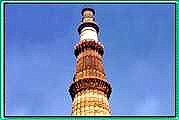 |
Qutab Minar was started by Qutab-ud-din Aibak in 1193 and the mosque was completed in 1197. Even in ruin, the Quwwat Ul Islam(Light of Islam) Mosque in the Qutab complex is one of the most magnificent in the world. | |
PURANA QUILA | |
The fort is said to be constructed on the historic site of Indraprastha (900 BC) by Humayun and Sher Shah. The mosque, built around 1541-42 is a landmark in Indo Islamic architecture. |
|
RED FORT | |
The Mughals emperor, Shah Jahan, after ruling from Agra for eleven years, decided to shift to Delhi and laid the foundation stone of the Red Fort in 1618. So called because of the red stone with which it is built, the Red Fort is one of the most magnificent places in the world. India's history is also closely liked with this fort. |
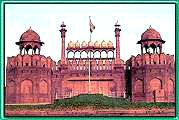
|
It was from here that the British deposed the last Mughal ruler, Bahadur Shah Zafar, marking the end of the three century long Mughal rule. It was also from its ramparts that the first prime minister of India, Pandit Jawahar Lal Nehru, announced to the nation that India was free from colonial rule. Humayun's Tomb, Jantar Mantar observatory built by Sawai Jai Singh of Jaipur to correct the error of brass and metal astronomical instruments. Safdarjang's Tomb, India Gate and Rashtrapati Bhawan are some other places to visit in Delhi. | |
CHANDNI CHOWK | |
Chandni Chowk, its nerve centre, is still a very busy commercial centre, and in its ancient, narrow lanes is kept alive the traditional workmanship which makes Delhi famous. |
|
JAMA MASJID | |
Jama Masjid is the largest mosque in India, and stands across the road from the Red Fort. Built in 1656, it is an eloquent reminder of the Mughal religious fervour. Its spacious courtyard can hold thousands of people. |
|
CONNAUGHT PLACE | |
Connaught Place is the foremost shopping centre of New Delhi, built in a horse-shoe pattern, consisting of inner, middle and outer circles. It came up in 1931 with the official transfer of the capital from Calcutta to Delhi. |
|
JANTAR MANTAR | |
Jantar Mantar is an astronomical observatory with masonry instruments, built in 1724 by Jai Singh, the mathematician and astronomer king. The Samrat or Yantra supreme instrument, the largest structure shaped like a right-angled triangle, is actually a huge sun-dial; the other five instruments are intended to show the movements of the sun, moon, etc. |
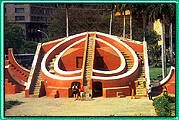
|
INDIA GATE | |
India Gate is a majestic high arch, 42 metres high, built as a memorial to the Indian soldiers killed in World War I. Beneath it burns an eternal flame. From the base of the arch one can get a good view of Rashtrapati Bhavan. |
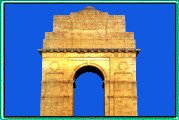 |
RASHTRAPATI BHAVAN | |
Rashtrapati Bhavan is the official residence of the President of India. Formerly the residence of the Viceroy of India, it has a magnificent view of the Rajpath and symmetrical North and South Block Government offices. Designed by Sir Edwin Lutyens and occupied in 1929, it is set in 330 acres of land. Imperial in design, it has spacious state rooms and an elegant Mughal Garden open to the public once a year, around February and March. |
|
HUMAYUN'S TOMB | |
Humayun's Tomb was built by Humayns's widowed Queen Haji Begum, in the 16th century. Architecturally the forerunner of the Taj Mahal, it stands in Nizamuddin which has Mughal architecture at its graceful best. |
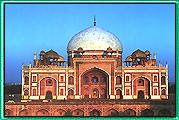 |
|